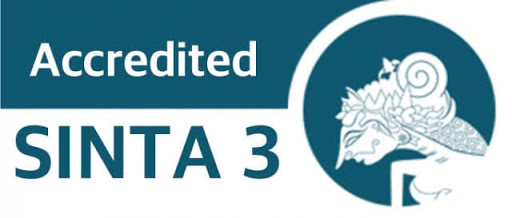IMPROVING ENGLISH STUDENTS’ READING COMPREHENSION AND LEARNING DIFFICULTY BASED ON SOME VARIABLES
Abstract
Experimental study in this article is aimed to investigate the effect of reading comprehension improvement for English language students toward their learning difficulty by using the reading speed strategy and identify the effect of gender and teaching method on the improvement of students’ reading comprehension. To achieve the objectives, a test was prepared to measure students’ reading comprehension after ensuring validity and reliability. The study involved 200 English students of the schools registered in Direktorat Pendidikan Wilayah Irbid II in the academic year of 2020/2021. They were 80 males and females, who are selected by using a simple method. The sample was categorized into two experimental groups with training and two control groups with the same material learning in a traditional method. The test was distributed to the groups before applying the strategy to ensure the whole group. The result showed that there are differences between the mean score of experimental group and the mean score of control group, and in favor of the experimental group. The result also showed that there are no differences among the mean score of students, which is attributed to gender.
Keywords
Full Text:
PDF (ENGLISH)References
Abu Riash, M. (2009). Learn to read fast. Amman: House of Culture for Publishing and Distribution.
Al-Dhanhani, R. (2008). The effectiveness of a language educational program in developing reading and listening comprehension skills for basic stage students in the United Arab Emirates. Ph.D. thesis, Amman Arab University for Postgraduate Studies.
Al-mousah, M. H. A. (2020). The effect of a strategy based on the communicative approach in reading comprehension for tenth grade students in Jordan. Journal of Educational and Psychological Sciences, 4(18).
Anderson, R.C., Wilson, P.T., & Fielding, L.G.(2010) Growth in reading and how children spend their time outside of school. Reading Research Quarterly.
Andre, D. Christine, E & Renee, O.(2011). The Validity of Reading Comprehension Rate: Reading Speed, Comprehension, And Comprehension Rates. Psychology in the Schools.
Babayigit, Ö. (2019). The Reading Speed of Elementary School Students on the All Text Written with Capital and Lowercase Letters. Universal Journal of Educational Research, 7(2), 371-380.
Bani Issa, M. (2010). The Effect of Paul Skelly's Method on Reading Speed and Reading Comprehension of Outstanding Students in the Basic Stage in Jordan. PhD Thesis, Yarmouk University, Irbid, Jordan.
Deniz, S., & Yavuz, M. (2020). Investigation of Reading Error Types, Reading Levels and Reading Speeds of Students with Special Learning Difficulties. Cypriot Journal of Educational Sciences, 15(4), 686-698.
Durukan, E. (2020). Impact of Speed Reading Training on Reading Speeds and Comprehension Skills of Secondary School Students. Cypriot Journal of Educational Sciences, 15(2), 184-193.
Elizabeth, B.M, Juliana, S.M,& George, W.H.(2010). Reading fluency: implications for the assessment of children with reading disabilities. Ann Of Dyslexia, 60, 1-17, 2010.
Fadlallah, M. (2015). Levels of reading comprehension and skills required for Arabic language book questions in general education stages in the United Arab Emirates. Reading and Knowledge Magazine.
Harthi, Y. M. (2020). The effectiveness of the use of Robinson's Strategy SQ3R in developing reading absorption skills with my timeless language course for middle-class second-graders. Journal of Educational and Psychological Sciences, 4(25).
Jad, M. L. (2013). The effectiveness of a suggested strategy in developing some reading comprehension skills for second-grade middle school pupils. Reading and Knowledge Magazine.
Kotzer, M., Kirby, J. R., & Heggie, L. (2021). Morphological Awareness Predicts Reading Comprehension in Adults. Reading Psychology, 1-21.
Khasawneh, M. A. S. (2021). An Electronic Training Program to Treat Errors of Reading Aloud in the English Language Among Students with Learning Difficulties During The Emerging Covid-19. EDUCATIO, 5(3).
Khasawneh, M. (2020). The effect of the spread of the new COVID-19 on the psychological and social adaptation of families of persons with disabilities in the Kingdom of Saudi Arabia. Health Psychology Report, 8(1).
Khasawneh, M. A. S. (2020). The problems facing students of English with learning disabilities from their teachers' point of view. Journal of Research and Educational Research Evaluation, 9(2), 70-77.
Khasawneh, M. A. S., & Alkhawaldeh, M. A. (2020). The Effectiveness of Phonological Awareness Training in Treating Deficiencies in Auditory Processing Among Children with Learning Disabilities Among Elementary Cycle Students in Saudi Arabia. International Journal of Language Education, 4(3).
Pollack, M. S., Shelton, A., Clancy, E., & Lemons, C. J. (2021). Sentence-level gist: Literacy instruction for students with learning disabilities in co-taught classrooms. Intervention in School and Clinic, 1053451220944378.
Quinn, J. M., Wagner, R. K., Petscher, Y., Roberts, G., Menzel, A. J., & Schatschneider, C. (2020). Differential codevelopment of vocabulary knowledge and reading comprehension for students with and without learning disabilities. Journal of educational psychology, 112(3), 608.
Qodri, M. (2020). Reciprocal education in teaching critical and creative reading comprehension skills. Jurnal Pendidikan Bahasa Arab dan Budaya Islam, 1(02), 77-90.
Rahimi, M., & Babaei, S. A. (2021). The Relationship between Reading Strategy Use and Reading Comprehension as Mediated by Reading Rate: The Case of Eye Movement Training by Rapid Serial Visual Presentation (RSVP). Teaching English with Technology, 21(1), 94-111.
Randy, G. Andrea, D. Christine, N. & Emily, P.(2011). Word Correct Per Minute: The Variance in Standardized Reading Scores Accounted for by Reading Speed. Psychology in the Schools. 48(2) , 87- 101.
Raslan, M. (2015). Teaching Arabic Language. Cairo: House of Culture for Publishing and Distribution.
DOI: http://dx.doi.org/10.33578/pjr.v6i2.8394
Refbacks
- There are currently no refbacks.
Copyright (c) 2022 JURNAL PAJAR (Pendidikan dan Pengajaran)

This work is licensed under a Creative Commons Attribution-NonCommercial-ShareAlike 4.0 International License.
JURNAL PAJAR (Pendidikan dan Pengajaran)
Secretariat
Program Studi Pendidikan Guru Sekolah Dasar
Gedung B1, FKIP Universitas Riau
Kampus Bina Widya Km. 12,5 Simpang Baru Panam
Pekanbaru Riau Indonesia 28293
e-mail : pajar@ejournal.unri.ac.id



